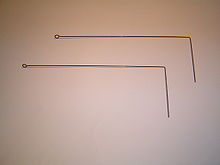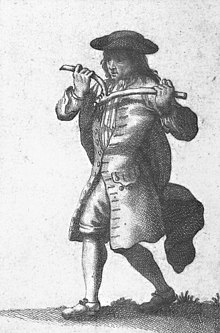Divining rod
The divining rod is mostly a Y-shaped forked instrument made from a fork of a branch or bent wire, which in the hand of a so-called dowser is supposed to react to the forces of attraction or radiations of ores and metals , water veins , geological faults or hidden objects in the ground. This idea was first documented in the late Middle Ages , but has never been scientifically proven. The doctrine of such alleged radiation effects is called radiesthesia .
More recently, L-shaped angled rods and antenna-shaped single-handed rods (“tensors”) have also been used as divining rods. In the case of angled rods, the shafts are placed next to one another or crossed, in the case of tensors a ring or ball is attached to the end of the rod. One-handed rods of this type are also used in alternative medicine .
etymology
The word divining rod is derived from ahd. Wunsciligerta , which appears in the Old High German glosses as a translation for Latin caduceus , the winged staff of Hermes. The compound with the diminutive of ahd. Wunsc "wish" is explained with the possibility of meaning "happiness, salvation" and wunsciligerta interpreted by Jacob Grimm as "the possession of which one is able to participate in all earthly welfare".
In Old and Middle High German (mhd. Wunschelruote , also Wunschelrîs, Wunschelwip, Wunschelgerte ) the word generally designates a staff or a whip with miraculous or magical power, which gives the owner special power, as also explained in the Nibelungenlied ( who can understand the would-be master sîn / wol in all widespread knowledge of the interior : " whoever had researched this could be a master in the whole world over every human being"). In addition, it is used in Middle High German as a paraphrase for the penis ( Konrad von Megenberg : schwantz or wuntzelruht ) and, in connection with the Christian interpretation of the root Jesse, as an image of the praise of Mary ( Gottfried von Straßburg : “der genade ein Wunschelruote”) or, more generally, of women's praise (In the Younger Titurel about Sigune: du Wunschelruot des grales ).
The common use of the word today, specifically to designate a mostly fork-shaped rod to track down hidden materials, has been documented since early New High German times.
history
The exact historical origin of dowsing rods is unknown. In older cultures there is often talk of rods or rods with miraculous power, such as the already mentioned rod of Hermes (Greek mythology), which opens the gates to the underworld , or the Moses rod, which lets water leap out of the rock in the desert (Num. 20.11).
Rods or rods for mantic and divinatory practices have been known since ancient times. Clear evidence of dowsing as we understand it today has only been found since the late Middle Ages .

Around 1430, the Goslar miner Andreas de Solea offers the oldest known evidence for the idea that a rod reacts to the radiation of metals. A few instructions for the manufacture and use of dowsing rods have survived from the 15th century, as well as incantation texts that had to be spoken during or before the rods were used. In 1517 Martin Luther mentioned in his interpretation of the Ten Commandments under the violations of the First Commandment, among other magical practices, the search for hidden treasures with the “virga divinationis”. Finally, Georgius Agricola , who briefly mentions it in 1530 in the glossary for his Bermannus as "Virgula diuina / die rute" and also regularly depicted the cadastral staff in the frontispiece of his print editions as a sign of mining research, dedicates it to the virgula furcata (forked rod) in 1556 Font De re metallica the first detailed treatment, also for the first time accompanied by a picture of a dowser.
Accordingly, in Agricola's time, dowsing was a technique that was widespread among miners and developed - namely by preferring specific woods for certain metals - artfully differentiated technique, which was, however, already very controversial: while critics declared it useless or as an explanation for the effect not an attraction of metals, but only wanted to accept the spells of the dowsers, proponents said that success did not depend on magic, but on the size of the rod, its forked shape, the attraction of the metals, the handling of the rod and also on the fact that the dowser does not have a particular obstructive disposition that overrides the attraction of metals and is responsible for the failure of inspections by unsuitable persons. Agricola himself took the side of the critics, as he attributed the effect to the spells, which he did not want to reproduce, and to chance as well as his skilful exploitation by the dowsers and, moreover, recommended that when finding the metals instead of their natural signs to pay attention.
In 1692, Jacques Aymar caused a sensation in France on the occasion of a murder case in Lyon by using his rod to allegedly discovered evidence that was buried at the scene of the crime, also to track down and convict one of the perpetrators with his rod and to use the rod to find and convict two other accomplices to escape Could trace border. Experimental tests of his abilities under the supervision of the Prince de Condé , during which Aymar was deliberately deceived about the actual course of the incidents to be investigated, are said to have falsified the effectiveness of his method.
In the 18th century the French physicist Thouvenel published several memoranda on two source finders, Bleton and Pennet, and these attempts were continued in Italy by Fortis and Amoretti, in Germany by Johann Wilhelm Ritter , Franz Xaver von Baader and Kieser. They believed in a special "electrometric" force that is excited in irritable (sensitive) people by metal veins or subterranean moving water. This force is said to have manifested itself not only in movements of objects held in the hand but also in physical sensations and even convulsions .
Instead of the wooden stick, several of these “metal and source detectors” also used the so-called “bipolar cylinder” and the “sidereal pendulum”. These tools were used in particular by the Italian Francesco Campetti , with whom Amoretti and the physicists at the Munich Academy experimented in the first decades of the 19th century. The bipolar cylinder is a metal rod held between the index finger and thumb, the sidereal pendulum is a piece of coal or pebbles suspended from a thread, which should vibrate under the influence of hidden metals and flowing water.
Animal electricity, the associated “ animal magnetism ” and similar concepts such as tellurism and siderism as well as the life force “Od” by Karl von Reichenbach were used as an explanation . Ultimately, Gilbert, Marechaux, Erman and Pfaff, among others, justified the view that these are merely unconscious ideomotor movements . Zeidler had already shown in his pantomystery published in 1700 that the rod moves when the person who wears it thought he had found the object he was looking for.
In the 1930s, the physicists Josef Wimmer and Joseph Wüst undertook research on divining rods (partly at the chair for anatomy in Munich with Benno Romeis ). Wimmer also ensured that the dowsing rod was used as the head of applied geology at the SS Ahnenerbe .
present
Even today, many people consider the dowsing rod to be a suitable instrument for tracking down allegedly existing water veins. The dowsers are commissioned by both private individuals and companies. The German Society for Technical Cooperation, for example, used dowsers to search for water in well construction projects. ASFINAG , the autobahn and expressway financing company that operates the network of motorways and expressways in Austria, used dowsers and commuters to reduce accidents until 2007, along with other measures.
Sometimes modern dowsing rods are also manufactured in the form of high-tech imitating detection devices, but their functionality does not differ from classic dowsing rods. The New York Times reported in 2009 on a device with an antenna that is used in Iraq to track down explosives and drugs. A review of the device revealed that it was unsuitable for detecting explosives and drugs. The Iraqi Interior Minister Jehad al-Jabiri, however, maintains that the device is functional. Comparable devices were also unable to achieve success beyond the random detection of explosives.
evaluation
On the occasion of the directors' conference of the geological state offices and the state offices for soil research of the Federal Republic of Germany , the following declaration was published by the participating professors on March 23, 1950:
“The geology of almost all civilized states, especially in Germany, has for many years, in order to leave no stone unturned, concerned with numerous exact tests of the divining rod (the pendulum and devices like the divining rod). She never failed to compare the information given by dowsers with the actual conditions of the subsoil. The clear result is that a connection between the dowsing rod (pendulum) deflection and the subsurface has not been proven, or even made probable.
The directors of the geological state offices mentioned must therefore expressly point out that the dowsing rod is completely useless for prospecting mineral resources of any kind, including water. Above all, in all work that is wholly or partially financed by public funds, the use of the dowsing rod must be decidedly rejected due to scientific knowledge. "
In the natural sciences today there is a consensus that the alleged physical interdependencies do not exist. The swinging of the dowsing rod or comparable pendulum instruments is instead often explained as the effect of an ideomotor process ( Carpenter effect ), in which the mental image of a certain movement triggers unconscious movement impulses in those muscles that are necessary to carry out the movement.
Following a request from member of the Bundestag Franz Heinrich Krey, the federal government approved funds to investigate possible connections between so-called earth rays and cancer. Professors König and Betz were commissioned in 1986 in Munich to carry out these investigations, which have come to be known as “barn experiments” . The actual research assignment could not be fulfilled. The results showed, however, that “the accuracy of the average dowser in the test series was poor” and “in most cases it was difficult or indistinguishable from chance”. According to Betz and König, however, some dowsers showed "extraordinary accuracy in special tasks which can hardly be explained by chance or not at all". This interpretation has been critically criticized by James Thomas Enright, among others. Enright criticized the subsequent choice of the data analysis method. He found that if current statistical methods were used, all results would be in the range of the statistically expected random values.
The Society for the Scientific Investigation of Parasciences (GWUP) has also expressly contradicted the approach of Betz and König and thereupon carried out its own experimental checks, which, according to the association, also did not reveal any significant deviations from the expected random hits. According to the GWUP, all "well-controlled and double-blind experiments that tested the most varied of claims from searching for water to finding gold to searching for electrical lines have so far resulted in negative results (...)"
literature
- Georg Franzius : Some experiments on the effects of electrical lines on the dowser. A protocol. Wittwer, Stuttgart 1913.
- Georg Franzius: Report on the meeting of the association to clarify the dowsing rod question in Halle a. Pp. 18. – 20. Sept. 1913. Stuttgart 1914.
- Herald: Article divining rod. In: Hanns Bächtold-Stäubli , Eduard Hoffmann-Krayer (Hrsg.): Concise dictionary of German superstition . Walter de Gruyter, Berlin 1927-42 (Reprint Berlin: de Gruyter 2000), Volume 9, 1941, pp. 823-839.
- Carus Sterne: Divination from the movements of lifeless bodies under the influence of the human hand. Weimar 1862.
- Herbert L. König, Hans-Dieter Betz: The divining rod report - Scientific investigation report. 1989, ISBN 3-923819-05-6 .
- Hubert Knoblauch : The world of dowsers and commuters - exploring a hidden reality. Campus Verlag, Frankfurt a. M. / New York 1991.
- Otto Prokop , Wolf Wimmer: dowsing rod, earth rays, radiesthesia. The occult radiation sensitivity teachings in the light of science. 3. Edition. Ferdinand Enke Verlag, Stuttgart 1985, ISBN 3-432-84473-5 .
Web links
- George P. Hansen: Dowsing: A Review of Experimental Research. In: Journal of the Society for Psychical Research , Vol. 51, No. 792, October 1982, pp. 343-367
- Hans-Dieter Betz : Unconventional Water Detection ( Memento from October 5, 2008 in the Internet Archive ). In: Journal of Scientific Exploration 9 (1995)
- In the matter of dowsing on ARTE (2005)
- Friedrich Balck : Biosensor - extended perception, increased perception
- Earth radiation advice at the Institute for Geophysics at the University of Stuttgart
Individual evidence
- ↑ Article Radiesthesia in Der Brockhaus multimedial , 2005.
- ↑ Jacob Grimm: German Mythology. 2. revised Ed. 1844, pp. 926–929, (“Wünschelruthe”) p. 926.
- ^ A b Jacob and Wilhelm Grimm: German Dictionary . Volume 30, 1960, Sp. 2035 ff., Online at Woerterbuchnetz.de, accessed on January 4, 2017.
-
^ William Barrett, Theodore Besterman: The Divining Rod: An Experimental and Psychological Investigation. Methuen, London 1926, pp. 1 ff. ( A Brief Historical Sketch of Browsing );
Gaston Burridge: Does the Forked Stick Locate Anything? An Inquiry into the Art of Dowsing. In: Western Folklore. 14.1, 1955, pp. 32-43;
Michael R. Lynn: Divining the Enlightenment: Public Opinion and Popular Science in Old Regime France. In: Isis 91.1, 2001, pp. 34-54. - ↑ From Barrett, Besterman: The Divining Rod. 1926, p. 7, note 1, quoted from Carl Kiesewetter: History of the modern occultism. Friedrich, Leipzig 1891–1895, Theil I, p. 512, Theil II, p. 382.
- ↑ artesliteratur.de: Divining rod. ( Memento from March 19, 2016 in the Internet Archive )
-
↑ Martin Luther: Decem praecepta Wittenbergensi populo praedicta, per RPD Martinum Lutherum Augustinianum, anno MDXVII. Iohannem Lufft, Wittenberg 1550, fol. 4r: "qui uirga diuinationis, occultos querunt thesauros".
Another mention can be found in the table speeches printed by Aurifaber in 1566, cf. Karl Eduard Förstemann (Ed.): D. Martin Luther's all writings. In: Vol. XXII: Speeches or Colloquia. Gebauer'sche Buchhandlung, Leipzig 1846, p. 213: "You also need divining rods so that you look for silver, like in the mines". - ↑ Georgius Agricola: Bermannvs, sive, De re metallica. Frobeniana, Basel 1530, p. 135 ( digitized version ).
- ^ Georgius Agricola: De re metallica libri XII. Basel 1556, pp. 25–28 ( not yet available in the digital edition ( Memento of July 9, 2007 in the Internet Archive ), 2nd edition 1561, p. 26 ff. ( Digitized version), German translation by Carl Schiffner [and others]: Twelve books on mining and metallurgy. VDI-Verlag, Berlin 1928, p. 30 ff. ( Digitized version; PDF; 1.7 MB).
- ↑ Hans-Dieter Betz: Unconventional Water Detection. ( Memento of November 4, 2009 in the Internet Archive ) In: Journal of Scientific Exploration. No. 9, 1995, pp. 3-11 (PDF; 419 kB).
-
↑ Ulrich Berger: [1] In: The standard. November 24, 2007;
Max Rauner: The magician of Bludenz. In: The time . 01/2007. - ↑ Rod Nordland: Iraq Swears by Bomb Detector US Sees as Useless. In: The New York Times. September 3, 2009.
- ↑ Otto Prokop, Wolf Wimmer: The modern occultism: Parapsychology and Paramedicine. Magic and Science in the 20th Century. University of Michigan, 1976, p. 18.
- ↑ For older research see Evon Z. Vogt: Water Witching: An Interpretation of a Ritual Pattern in a Rural American Community. In: The Scientific Monthly 75,3 (1952), pp. 175-186, here p. 175.
- ↑ Ray Hyman: Psychology and 'Alternative Medicine': The Mischief-Making of Ideomotor Action ( Memento from July 19, 2011 in the Internet Archive ). In: The Scientific Review of Alternative Medicine 3.2 (1999), pp. 34-43.
- ^ Herbert L. König, Hans-Dieter Betz: Earth rays? The divining rod report - Scientific research report , self-published, Munich 1989. The unpublished final report 01 KB8602 to the Ministry (BMFT, 1990) comes from the same authors .
- ↑ James T. Enright: Water dowsing: The barn experiments. In: Naturwissenschaften 82 (1995), pp. 360-369. The reply by Hans-Dieter Betz, Herbert L. König, R. Kulzer, R. Trischler, J. Wagner: Dowsing reviewed - the effect persists. In: Naturwissenschaften 83 (1996), pp. 272-275.
- ↑ James T. Enright: Dowsers lost in a barn. In: Naturwissenschaften 83 (1996), pp. 275-277.
- ↑ Martin Lambeck: Are physics wrong? About alternative medicine and esotericism. CH Beck, Munich 2003, p. 123 ff., There especially p. 126 f .: “The Enright - Betz Controversy”.
- ↑ J. Moll, H. Richter, C. H. Ross, A. Sarma, J. Windeler: Statement of the Society for the Scientific Investigation of Parasciences (GWUP) on the "Divining Rods Report". In: Skeptiker 1989/4, pp. 11-14.
- ↑ R. König, J. Moll, A. Sarma: Dowsing rod test in Kassel. In: Skeptiker 1991/1, pp. 4–10.
- ^ Robert Todd Carroll: The Skeptic's Dictionary: A Collection of Strange Beliefs, Amusing Deceptions, and Dangerous Delusions. Wiley, New York [et. a.] 2003, p. 107.
- ↑ Martin Lambeck: Are physics wrong? About alternative medicine and esotericism. CH Beck, Munich 2003, p. 123 ff.
- ↑ www.gwup.org: Earth rays ( Memento from December 22, 2008 in the Internet Archive ).




